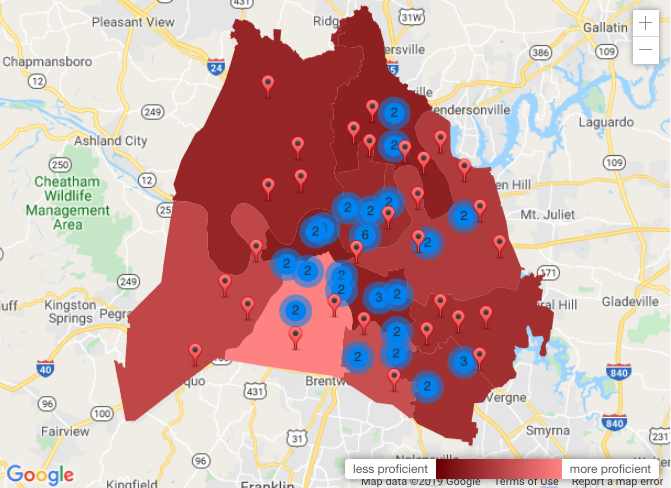In 2019, the Scarlett Family Foundation released the Cluster Profiles resource, a data-driven look into the performance and demographic metrics of Metro Nashville Public Schools (MNPS) zoned school clusters. With these profiles – one for each MNPS high school feeder pattern or “cluster” – we aim to present the educational pathways of students who choose to attend their zoned school from elementary through high school. This month, we’ve released an updated version of these pages, to include school data from the 2018-19 school year. With this updated data, one stark truth remains the same: too many Nashville students attend low-performing schools.
In some cases, the data are startling. In the Maplewood cluster, a child may very well attend a Priority school – a school ranking in the bottom 5% of public schools statewide – for every year of their K-12 education. The same is true of the White’s Creek cluster. Still, there are bright spots to celebrate: in the Hunters Lane cluster, Gateway Elementary stands out as the only Reward school (ranking in the top 5% of public schools state-wide) in a cluster that includes four Priority schools. The accomplishments of this school community deserve celebration, and the same can be said for dozens of others within MNPS. However, taken together, the Cluster Profile data overwhelmingly point to a lack of high-quality public school options within the zoned pathways.
Though no cluster is perfect, we must acknowledge the distinct geographic divide in the location of our city’s highest-performing traditional public schools. These are found disproportionately in the West Nashville area, with Hillsboro and Hillwood clusters standing out as two primary examples. Both clusters contain three Reward schools, and high school graduates in these clusters post ACT scores of 19.9 and 18.9, respectively – the highest average ACT scores among all MNPS clusters.
Students in East and North Nashville, in clusters such as Pearl-Cohn or Hunters Lane, are far more likely to follow a K-12 pathway dominated by some of our lowest-performing schools. Three of the Pearl-Cohn cluster’s seven schools are Priority schools, and Hunters Lane High School – the only zoned high school option for families in this cluster – rank near the bottom for every metric included on our profiles.
This year’s updated Cluster Profiles include two new metrics: Three Year Enrollment Trend and Building Utilization Capacity. With the addition of these measurements, we are able to better understand changes in school population, which may point to broader population trends in a particular neighborhood. For example, we can see that the Hillwood cluster has experienced a -14% three-year enrollment trend decline, while the Overton cluster has seen a 10% enrollment increase in the same time period. With this information, we are prompted to wonder whether Nashville families are leaving the Hillwood cluster for another area of the city, or if they might be choosing to enroll their students in schools outside of their cluster. Conversely, the Overton cluster’s enrollment increase trend indicates that this Nashville neighborhood might be experiencing population growth, or perhaps Overton High School has attracted a large number of new students through MNPS’ high school open enrollment system.
The addition of the Building Utilization Capacity metric serves a similar purpose – if we know what percentage of student seats in a school building are occupied, we can understand not only the utilization and therefore the cost efficiency of the facility, but also how families in a particular neighborhood are taking advantage of their zoned school options. If a cluster’s building utilization capacity falls on the low-end – like the 57% measure observed in the Maplewood cluster – we might draw the conclusion that the school-aged population choosing to attend zoned schools within this cluster has decreased over some period of time. On the other end of the spectrum, we see that buildings in the Cane Ridge cluster are utilized at a rate of 100%, indicating that students filled all seats planned for that cluster’s school buildings in the 2018-19 school year.
Though the updated Cluster Profiles allow us the opportunity to better know our MNPS zoned schools, the data leave us with a disappointing conclusion: we still cannot say that every child in Nashville has access to a high-quality education. Though some clusters include high-performing magnet or charter school options, students who live in these cluster neighborhoods are not guaranteed a seat in such schools. Attending a non-zoned school option may also necessitate lengthy travel on the part of the student, making this option less than truly accessible. The truth remains that Nashville cannot currently offer an excellent public education to all of its children. At the Scarlett Family Foundation, we remain committed to driving positive change in this area.





















